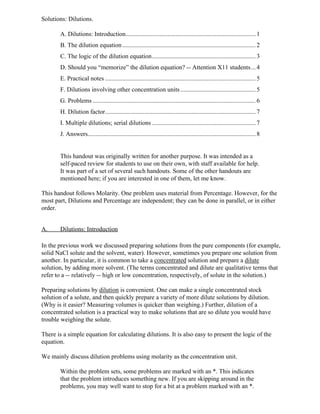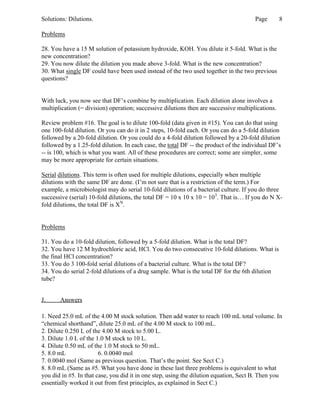This document provides guidance on dilution calculations and the dilution equation. It begins by introducing the concept of dilution and the convenience of making dilute solutions from concentrated stock solutions. [It then presents the dilution equation VcMc = VdMd and works through an example problem.] The logic behind the dilution equation is explained in terms of moles of solute. Emphasis is placed on understanding the meaning of the variables like Vc and using dimensional analysis to check work. Common mistakes are discussed and the document provides tips for solving dilution problems correctly.


![Solutions: Dilutions. Page 3
Note about Vc, and a hidden assumption. Vd is simple enough; it is the amount of the dilute
solution you are making. It may be tempting to think that Vc is the amount of the concentrated
solution you have. WRONG. It is the amount you use. So how much do you have? Don’t know,
except that it is plenty (an “excess”). You must have “enough” of the concentrated to do what
you want, but the amount you have per se is not an issue. You calculate how much you need,
and take that from the stock. (If there isn’t enough stock, someone needs to make more; see
Molarity.)
Pitfall; important check. The most common mistake in doing dilution calculations is to use the
equation backwards, to get c and d at least partially mixed up. The first protection against this
problem is to be careful with the units. Look at the example above. The M units cancel, and the
only remaining unit is the volume unit -- in the numerator. Thus the set-up gives volume, which
is what we want. If your set-up doesn’t give volume, or gives volume in the denominator, it is
wrong. Watch the units. (Remember, the point of using dimensional analysis is to guide you
toward correct set-ups and away from incorrect ones. Just writing the unit you know you want,
even if it doesn’t come out of the set-up, seriously misses the value of using dimensional
analysis.)
Unfortunately, dimensional analysis alone won’t protect you from the second part of the pitfall -
- but common sense will. What if you mix up the two concentrations, putting the wrong one on
top? You will still get volume, but you will get the wrong volume -- an obviously unreasonable
volume. In the example, if you reverse the two concentration terms, you will get Vd = 500 mL.
This “answer” says to take 500 mL of stock solution, and add water until you get to 100 mL.
Nonsense! Obviously nonsense!
The overall message… watch the units and check that the result seems reasonable. These
precautions are good general precautions in all problems.
If you can’t exactly recall the dilution equation, the precautions may be enough to guide you to
do the calculation correctly. The desired volume must be the given volume times the ratio of
concentrations; that will give you volume. And the ratio of concentrations must be written so
that the answer comes out as reasonable.
C. The logic of the dilution equation
[You do not need to understand the basis of the dilution equation in order to
properly use it. However, the equation is rather easy to understand, and
understanding it can help develop your intuition about how to approach
problems. Further, if you do dilution calculations only occasionally, it may
actually be easier and safer to solve them “from first principles” than to try to
remember the dilution equation and to use it properly.]
Think moles. Once again, the mole underlies chemical logic.
You know that](https://image.slidesharecdn.com/dilution-121111235654-phpapp02/85/Dilution-3-320.jpg)





